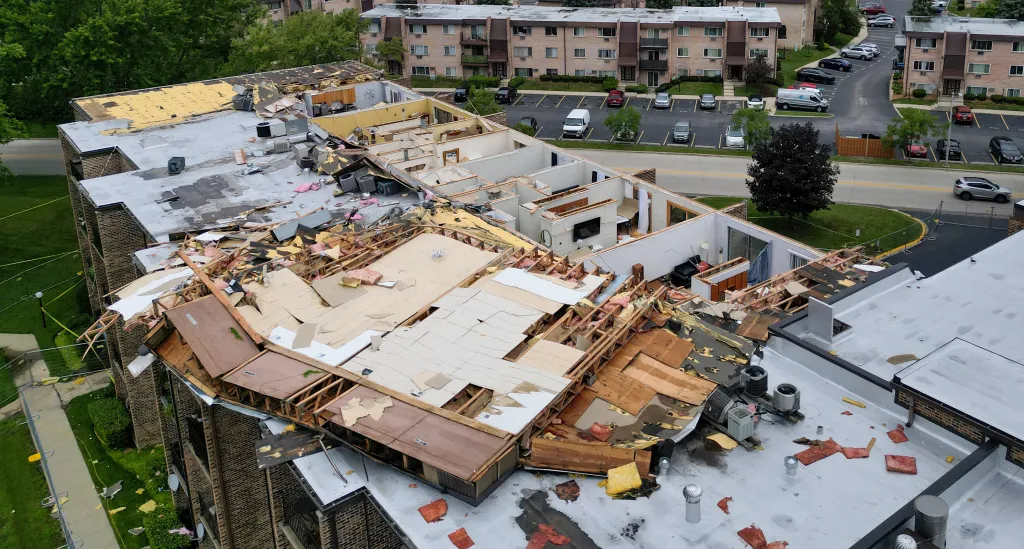Copyright Chicago Tribune

The city of Chicago, Cook County and the state of Illinois are appealing President Donald Trump’s denial last week of a disaster declaration that would have unlocked federal financial assistance for survivors and public repairs after heavy rains and flooding in the state in July and August. A joint news release on Tuesday noted that flooding from the storms on July 25-28 and Aug. 16-19 caused “widespread property damage, prolonged power outages, and significant disruptions to transportation and essential services” across Illinois. The heavy rains displaced residents, left thousands without electricity, led to collapsed ceilings from water damage, flooded basements and roadways, overflowed rivers, broken boilers, furnaces and other large appliances, and triggered ground stops at Midway and O’Hare International airports. “I will say, Illinois is not alone. They’ve rejected requests from a number of states this year already,” said Andy Winkler, managing director of housing and infrastructure policy at the Washington-based Bipartisan Policy Center and manager of the think tank’s Disaster Response Reform Task Force. “This batch of rejections — it looks more political, but it is consistent with what they’ve been doing across the board, to really only approve the highest-profile disasters.” In recent years, as climate change has fueled more intense events from flooding to wildfires, the federal government has taken on a larger financial responsibility for natural disaster recovery. But that approach is being curtailed under the Trump administration. “We now are very abruptly shifting the financial burden of disaster recovery directly onto states and local governments,” Winkler said. According to an Associated Press report, the administration’s decisions have fallen mostly along party lines, with Trump touting on social media last week that he approved aid for Alaska, which he “won BIG” in the last three elections. “I will never let you down,” he wrote. Trump also approved disaster declarations for Nebraska, North Dakota and the Leech Lake Band of Ojibwe in Minnesota. He denied requests from Illinois, Wisconsin, Michigan and Vermont and has also denied an appeal from Maryland after the state was denied a disaster declaration for May flooding When asked why the states were denied, White House spokesperson Abigail Jackson said Trump was “ensuring American tax dollars are used appropriately and efficiently by the states to supplement — not substitute — their obligation to respond to and recover from disasters.” In Illinois, preliminary damage assessments in affected jurisdictions included Chicago and Aurora, as well as Cook, Will, Kane, Boone, McHenry, Jersey and Calhoun counties. Trump clinched the majority vote in the latter four counties during last year’s presidential election — with over 70% of the vote in Jersey and Calhoun in south central Illinois — fueling discussions about how the politicization of federal aid is not only harming blue states but also supporters of the current administration. Winkler said the impact on Trump voters has been a major sticking point for red North Carolina counties affected by flooding from Hurricane Helene last year that are still waiting for federal reimbursements for disaster recovery money that has already been spent. “I don’t know if people will blame the president personally,” Winkler said. “My bigger concern is that it further erodes the confidence that people have in government and its ability to help.” In a statement to Stateline, Brian Hughes, a spokesman for the National Security Council, said: “The Federal Government focuses its support on truly catastrophic disasters — massive hurricanes, devastating earthquakes, or wide-scale attacks on the homeland.” Hughes added that state and local governments “often remain an impediment to their own community’s resilience,” and called on states to take on a more extensive role, according to Stateline, and have “an appetite to own the problem.” Local leaders in Illinois and other states are already scrambling to address the growing dangers of extreme weather fueled by climate change. To appeal the president’s denial and strengthen the request for aid, the city’s Office for Emergency Management and Communications and the Illinois Emergency Management Agency are asking residents and businesses to share additional evidence of new or previously unreported information on damages and needs through Nov. 7. After the mid-August floods, Chicago Mayor Brandon Johnson surveyed storm damage in the Gage Park neighborhood. He proposed a few quick solutions: adding sensors in drains, planting thousands of trees and more aggressively clearing pipes. But, ultimately, the mayor said the city’s drainage system and infrastructure are insufficient and in need of repairs, and that prevention will require investments like progressive revenue — or “pay what you can” tax systems. “We’ll bring it to the residents and people can decide if we want to remain stagnant and continue to get what we have received, or do we want to press forward … so that families who are hurting from these floods don’t have to worry every time it rains,” he told reporters at the time. After storms caused wind damage across the Chicago region on July 24, a slow-moving line of storms with torrential rainfall the next day led to several instances of flash flooding across parts of Chicago, according to the National Weather Service. A weather station at Midway observed 3.25 inches of rain for the day — most of it falling over 3.5 hours. According to Cook County officials, Chicago, Burbank, Justice and Summit were among the hardest-hit municipalities in the county through July 28. When the county and Chicago issued a disaster proclamation nine days later, residents had filled out over 3,000 surveys reporting damage. The weekend of Aug. 16-17, a long line of severe thunderstorms that swept across Chicago and its suburbs left more than 60,000 Commonwealth Edison customers without power. Across the western and southern Chicago metropolitan area, local rain rates of 2 to 4.5 inches per hour were observed. Lee Carlaw, lead meteorologist at the weather service’s office in Chicago, told the Tribune then that the rain likely saturated the soil, making conditions more favorable for flash flooding through Aug. 19. During storms the next two days, rainfall totals were “highly variable,” from half an inch in downtown Chicago to 3 to 4 inches in the south suburbs, Carlaw said. Some locations in Cook and Will counties, such as Oak Forest, Lockport and Oswego, received anywhere between 6 and 9 inches of rain over a 72-hour period. According to the weather service, radar estimated that hourly rain rates on Aug. 18 at times approached 2 to 4 inches, resulting in numerous instances of flash flooding due to how fast it fell onto saturated soil and concrete urban environments, preventing it from being absorbed into the ground. After the storms passed, the city’s Department of Water Management Commissioner Randy Conner called the rain a “100-year” downpour. A week after the August flooding, Johnson and Cook County Board President Toni Preckwinkle signed disaster proclamations in what Johnson called “a necessary step” to help “our most vulnerable neighborhoods.” According to local officials, some areas in Chicago were already recovering from the July floods when they were hit by the August storms. Less than three days later, more than 4,000 surveys in the city and suburban Cook County had been filled out by residents who had experienced damage. “It’s clear that these massive events are occurring and people are not prepared; they’re at high risk,” Winkler said. State and local officials are urging residents affected by the rain and flooding on July 25-28 or Aug. 16-19 to fill out a self-assessment survey that will open Wednesday at 8 a.m. and will close Nov. 7 on the state’s website at iemaohs.illinois.gov/recovery. They are also asking residents and business owners to share photos of damage, documentation of alternative housing needs, reports of illness or health impacts, mold remediation efforts and replacement of furnaces, water heaters or other major appliances. The Associated Press and the Chicago Tribune’s Rebecca Johnson, Jake Sheridan, William Tong and Paulina Czupryna contributed.



